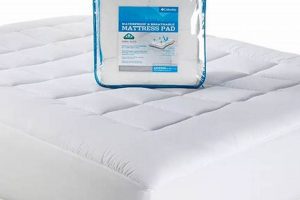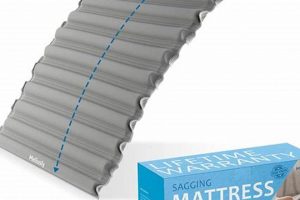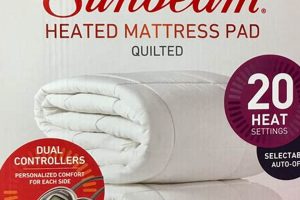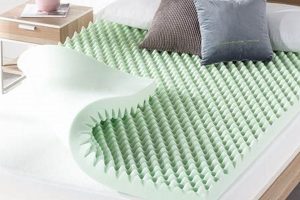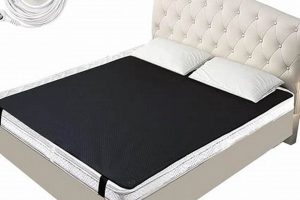The question of the well-being associated with electrically warmed bedding surfaces designed for placement on top of a mattress is a common concern. These devices, often featuring internal wires that generate heat when electricity is applied, aim to provide warmth and comfort during sleep. The safety profile of such products depends on several factors, including proper usage, adherence to manufacturer guidelines, and the quality of the device itself.
Addressing potential hazards is crucial due to the close proximity of these devices to the human body for extended periods. Advantages might include improved sleep quality for individuals sensitive to cold temperatures, potential relief from muscle stiffness, and energy savings by reducing the need to heat an entire room. The development and widespread adoption of these items have been influenced by the desire for enhanced comfort during colder months, along with advancements in heating technology and safety standards.
The following sections will examine potential risks associated with their use, including the possibility of overheating, electrical hazards, and electromagnetic field (EMF) exposure. Furthermore, guidance on selection, proper use, and maintenance practices to minimize potential risks and maximize safe operation will be provided. Finally, current safety standards and certifications relevant to these products will be outlined.
Safety Tips for Electrically Heated Mattress Overlays
The following guidelines promote the safe and effective operation of electrically heated mattress overlays, mitigating potential risks associated with their use.
Tip 1: Prioritize Certified Products: Ensure the chosen product carries certification from a recognized testing laboratory, such as UL, ETL, or similar. This indicates adherence to established safety standards.
Tip 2: Inspect Before Use: Before each use, carefully examine the pad and its power cord for any signs of wear, fraying, or damage. Discontinue use immediately if damage is detected.
Tip 3: Follow Manufacturer Instructions: Adhere strictly to the manufacturer’s guidelines regarding usage, temperature settings, and maintenance procedures. Deviation from these instructions can compromise safety.
Tip 4: Avoid Folding or Bunching: Ensure the pad is laid flat on the mattress without folds or bunches. Concentrated heat buildup in folded areas can lead to overheating and potential fire hazards.
Tip 5: Disconnect When Not in Use: Unplug the device from the power outlet when not actively in use. This reduces the risk of electrical hazards and prolongs the lifespan of the product.
Tip 6: Do Not Use with Infants or Incapacitated Individuals: Refrain from using these devices with infants, young children, or individuals who are unable to regulate their body temperature or respond to discomfort.
Tip 7: Replace Regularly: Electrically heated mattress overlays have a limited lifespan. Consider replacing the device every few years, or as recommended by the manufacturer, to ensure continued safe operation.
Tip 8: Avoid Dry Cleaning or Commercial Laundering: Most manufacturers advise against dry cleaning or commercial laundering, as these processes can damage the internal wiring. Refer to the product’s care instructions for appropriate cleaning methods.
By adhering to these recommendations, individuals can significantly reduce the likelihood of accidents or injuries associated with the use of these devices, while still enjoying the benefits of added warmth and comfort.
The next section will cover common misconceptions about potential risks and provide further clarification on mitigating safety concerns.
1. Overheating Potential
The risk of excessive heat generation is a primary concern regarding the safety of electrically warmed mattress overlays. This potential for overheating presents a direct threat of burns and, in extreme cases, fire. Mitigation of this risk is a critical aspect of ensuring the safe use of such products.
- Thermostat Malfunction
A defective thermostat can prevent the heating element from shutting off at the pre-set temperature. This can result in a continuous increase in heat output, potentially leading to dangerously high surface temperatures. Regular inspection and replacement of these components are essential preventative measures.
- Wire Damage and Hotspots
Compromised internal wiring, due to bending, folding, or general wear and tear, can create localized “hotspots” where resistance increases and heat becomes concentrated. This localized heating significantly elevates the risk of burns and fire. Consistent monitoring for wire damage is crucial.
- Insufficient Heat Dissipation
If the mattress overlay is covered by thick blankets or other insulating materials, the generated heat may not dissipate effectively. This trapped heat can lead to a gradual increase in temperature, exceeding safe levels. Ensuring adequate ventilation around the overlay is essential for safe operation.
- Automatic Shut-Off Failure
While many modern mattress overlays are equipped with automatic shut-off mechanisms designed to prevent overheating, these features can malfunction. Reliance solely on this safety mechanism is not advisable. Users should remain vigilant and monitor temperature levels periodically.
Collectively, these factors illustrate the significance of the overheating hazard. Vigilant inspection, adherence to manufacturer guidelines, and awareness of potential failure points are necessary components of safe operation, and are central to determining whether heated mattress overlays are safe for individual use.
2. Electrical Hazards
The question of electrical safety is paramount when considering the operation of any electrically powered device, including heated mattress overlays. Potential risks stem from the device’s direct connection to a power source and its prolonged contact with the user. Defective wiring, damaged insulation, or exposure to moisture can create pathways for electrical current to flow improperly, leading to shock or electrocution. For instance, a frayed power cord can expose live wires, posing a significant risk if touched, especially in a bedroom environment where contact with grounded objects is likely. The integrity of the power cord and the internal wiring is thus a critical component of ensuring the device is safe.
The presence of water or moisture further exacerbates electrical hazards. Spilled liquids or excessive humidity can compromise insulation and create conductive paths, increasing the likelihood of electrical leakage. Proper maintenance and adherence to usage guidelines, such as avoiding the use of heated mattress overl
ays in damp environments, are vital preventative measures. Furthermore, the design and construction of the device play a crucial role. Certified products undergo rigorous testing to ensure they meet established safety standards for insulation, grounding, and current leakage. These certifications provide a degree of assurance, but regular inspection and responsible use remain essential.
In conclusion, mitigating electrical hazards is an indispensable aspect of evaluating the safety of electrically warmed mattress overlays. This requires diligent attention to product selection, proper usage, and regular maintenance. Ignoring these considerations can lead to serious consequences, highlighting the importance of informed decision-making when using these devices. The presence of certification marks, consistent inspection for wear and tear, and avoidance of moisture exposure are all necessary steps in mitigating risk.
3. EMF Exposure
Electromagnetic field (EMF) exposure is an element in determining the safety profile of electrically heated mattress overlays. These devices, operating on electric current, inherently generate EMFs. The intensity and frequency of these fields vary depending on the device’s design, power level, and proximity to the user. Concerns regarding EMF exposure stem from potential long-term health effects associated with prolonged exposure, though conclusive evidence of significant harm from low-level EMFs remains a subject of ongoing scientific investigation. A primary cause of EMF generation is the flow of alternating current through the heating wires embedded within the overlay. The proximity of these wires to the body during sleep raises concerns about chronic exposure and its potential impact.
Manufacturers often implement design strategies to minimize EMF emissions. Shielding materials and specific wiring configurations are used to reduce the intensity of the electromagnetic fields emanating from the device. Certification standards, such as those established by Underwriters Laboratories (UL) or similar organizations, may include testing and limits on EMF emissions. Real-world examples include newer models incorporating low-EMF technology, which significantly reduces field strength compared to older designs. Understanding EMF exposure is practically significant, especially for individuals with heightened sensitivity or health concerns. Knowledge of the EMF levels produced by these devices enables informed decisions and the implementation of mitigation strategies, such as limiting usage time or increasing distance from the device.
In conclusion, EMF exposure represents a relevant consideration when evaluating the safety of electrically heated mattress overlays. While the scientific evidence regarding the health effects of low-level EMFs is still evolving, proactive measures to minimize exposure are warranted. Careful product selection, adherence to manufacturer guidelines, and awareness of potential risks contribute to a more informed and cautious approach. Challenges remain in establishing definitive causal links between low-level EMF exposure and specific health outcomes. Balancing the potential risks with the perceived benefits of these devices requires ongoing research and transparent communication of scientific findings to consumers.
4. Product Certification
Product certification serves as a critical indicator of the safety of electrically heated mattress overlays. Certification by recognized testing laboratories, such as UL, ETL, or CSA, signifies that the product has undergone rigorous evaluation to meet established safety standards. These standards encompass various aspects of the device’s design and performance, including electrical safety, fire resistance, and material composition. Adherence to these standards minimizes potential risks associated with overheating, electrical shock, and exposure to hazardous substances. The absence of certification raises concerns about the product’s safety and reliability, potentially exposing users to unacceptable levels of risk. For example, a certified mattress overlay must pass tests for flammability, ensuring it will not easily ignite in the event of a malfunction.
The certification process involves independent testing and verification of the product’s compliance with relevant safety requirements. Manufacturers seeking certification must submit their products to a testing laboratory, which conducts a series of tests to assess the product’s performance under normal and abnormal operating conditions. These tests may include assessments of insulation integrity, temperature regulation, and resistance to physical stress. Products that pass these tests receive a certification mark, indicating that they have met the required safety standards. Continued compliance is often maintained through periodic audits and retesting. Real-world incidents involving non-certified products have demonstrated the potential consequences of neglecting certification. Cases of overheating, electrical fires, and exposure to toxic materials have been linked to uncertified or counterfeit heated mattress overlays, highlighting the importance of verifying certification before purchase.
In summary, product certification offers a crucial layer of protection for consumers using electrically heated mattress overlays. It provides reasonable assurance that the product has been designed and manufactured to meet established safety standards. While certification does not guarantee absolute safety, it significantly reduces the likelihood of accidents or injuries. Consumers should prioritize certified products and verify the authenticity of certification marks before making a purchase. Challenges remain in ensuring consistent enforcement of certification standards and preventing the sale of counterfeit or non-compliant products. By recognizing the practical significance of product certification, consumers can make informed decisions and minimize the potential risks associated with the use of electrically heated bedding.
5. Proper Maintenance
The relationship between consistent upkeep and the safety of electrically heated mattress overlays is direct and significant. Adherence to recommended maintenance practices is paramount in mitigating potential hazards and ensuring continued safe operation.
- Cord and Wiring Inspection
Regular visual examination of the power cord and the overlay itself for signs of wear, fraying, or damage to the wiring is crucial. Compromised insulation or exposed wires pose an electrical shock hazard. Discontinuing use and replacing the device are necessary if damage is detected. For instance, a cord that has been repeatedly bent or pinched may develop internal breaks, increasing the risk of overheating or electrical arcing.
- Cleaning Procedures
Following the manufacturer’s instructions for cleaning is essential to prevent damage to the internal heating elements and wiring. Improper cleaning methods, such as dry cleaning or machine washing (unless specifically approved), can compromise the integrity of the device and increase the risk of electrical hazards. Residue from cleaning agents may also create conductive pathways, posing a shock hazard.
- Storage Practices
Proper
storage during periods of non-use can prevent damage and prolong the lifespan of the mattress overlay. Folding the device too tightly or storing it under heavy objects can damage the internal wiring. Storing the overlay in a dry environment prevents moisture damage, which can lead to corrosion and electrical shorts. Rolling the pad loosely is generally recommended for storage. - Control Unit Care
The control unit, which regulates temperature and power, should be kept free from dust and moisture. Overheating of the control unit can indicate a malfunction, and should be addressed promptly. Avoid placing the control unit under blankets or pillows, as this can impede ventilation and lead to overheating.
Collectively, these maintenance practices contribute significantly to the overall safety of electrically heated mattress overlays. Neglecting these procedures can increase the risk of electrical hazards, overheating, and fire. Prioritizing proper maintenance extends the lifespan of the device and ensures continued safe and comfortable use. Regular attention to these details is essential for maintaining a safe sleeping environment. Failure to maintain results in safety decline.
6. User Vulnerability
The safe operation of electrically heated mattress overlays is directly influenced by the user’s individual susceptibility to potential hazards. User vulnerability encompasses a range of factors, including age, physical and cognitive abilities, pre-existing health conditions, and sensory perception. These characteristics can significantly impact an individual’s capacity to recognize and respond to risks associated with the use of these devices. Infants, for example, lack the ability to regulate their body temperature effectively and cannot communicate discomfort, placing them at heightened risk of overheating. Similarly, individuals with impaired sensation, such as those with diabetes or neuropathy, may be unable to detect burns or other injuries caused by excessive heat. These circumstances create an increased risk profile that necessitates careful consideration when determining the suitability of electrically heated mattress overlays.
Furthermore, cognitive impairments, whether due to age-related decline, dementia, or other conditions, can compromise an individual’s ability to understand and adhere to safety instructions. This can lead to misuse of the device, such as setting the temperature too high or failing to inspect the device for damage. Individuals with mobility limitations may also be at increased risk, as they may have difficulty adjusting the temperature or disconnecting the device in an emergency. In practical terms, the presence of a vulnerable user requires heightened vigilance and the implementation of additional safety measures. This might involve regular monitoring of the device’s temperature, ensuring the user is capable of understanding and following safety instructions, or opting for alternative methods of warming the bed that do not pose the same level of risk. Real-world incidents highlight the potential consequences of neglecting user vulnerability. Cases of severe burns, particularly among elderly individuals with impaired sensation, underscore the importance of assessing individual risk factors before recommending the use of these devices.
In conclusion, user vulnerability represents a critical dimension of the safety profile of electrically heated mattress overlays. Recognizing and addressing individual risk factors is essential in mitigating potential hazards and ensuring the well-being of users. Challenges remain in developing standardized guidelines for assessing user vulnerability and providing tailored safety recommendations. A comprehensive approach that considers individual needs and limitations is necessary to promote the safe and responsible use of electrically heated bedding. Balancing the benefits of these devices with the potential risks to vulnerable users requires ongoing awareness, education, and a commitment to prioritizing safety above all else.
Frequently Asked Questions
The following questions address common concerns surrounding the safety of electrically heated mattress overlays, providing concise and informative answers based on available evidence and best practices.
Question 1: Can these devices cause fires?
The potential for fire exists, primarily due to overheating or electrical malfunctions. Adherence to manufacturer guidelines, regular inspection for damage, and certification by recognized testing laboratories significantly mitigate this risk.
Question 2: Is there a risk of electric shock?
Electric shock is a potential hazard, especially if the device is damaged or used improperly. Ensuring the device is certified, keeping it dry, and inspecting the power cord regularly are essential preventative measures.
Question 3: Are electromagnetic fields (EMFs) harmful?
Electrically heated mattress overlays do emit EMFs. While the long-term health effects of low-level EMF exposure are still under investigation, some individuals may prefer to minimize exposure by limiting usage time or choosing low-EMF models.
Question 4: Are they safe for individuals with diabetes?
Individuals with diabetes, particularly those with peripheral neuropathy, should exercise caution due to reduced sensation in their extremities. Overheating can cause burns that may go unnoticed. Careful temperature monitoring and consultation with a healthcare professional are advised.
Question 5: How often should these devices be replaced?
Manufacturers typically recommend replacing electrically heated mattress overlays every few years, or as indicated in the product manual. Regular replacement ensures that the device continues to meet safety standards and reduces the risk of malfunctions due to wear and tear.
Question 6: Is it safe to leave this device on all night?
Leaving electrically heated mattress overlays on all night is generally not recommended, especially at high settings. Overheating can occur, and prolonged exposure to heat may disrupt sleep patterns. Utilizing a timer or automatic shut-off feature is advisable.
In summary, understanding the potential risks and adhering to safety guidelines are essential for the safe use of electrically heated mattress overlays. Prudent use and regular maintenance significantly reduce the likelihood of accidents or injuries.
The subsequent section will provide a concluding overview, summarizing key safety considerations and offering final recommendations.
Are Heated Mattress Pads Safe
This analysis addressed the central query: are heated mattress pads safe? The examination revealed that while these devices offer comfort, their use necessitates careful consideration of potential risks. Overheating, electrical hazards, EMF exposure, and user vulnerability are factors that contribute to the overall safety profile. Product certification and proper maintenance were identified as critical elements in mitigating these risks. Individual circumstances and adherence to manufacturer guidelines are paramount in ensuring responsible usage.
Ultimately, determining safety resides with informed decision-making. Individuals must weigh the benefits against the potential risks, prioritize certified products, and consistently practice safe usage and maintenance. Continued research and advancements in safety technology are essential to further enhance the well-being associated with these devices. Prioritizing safety through informed practices is critical.
article>


